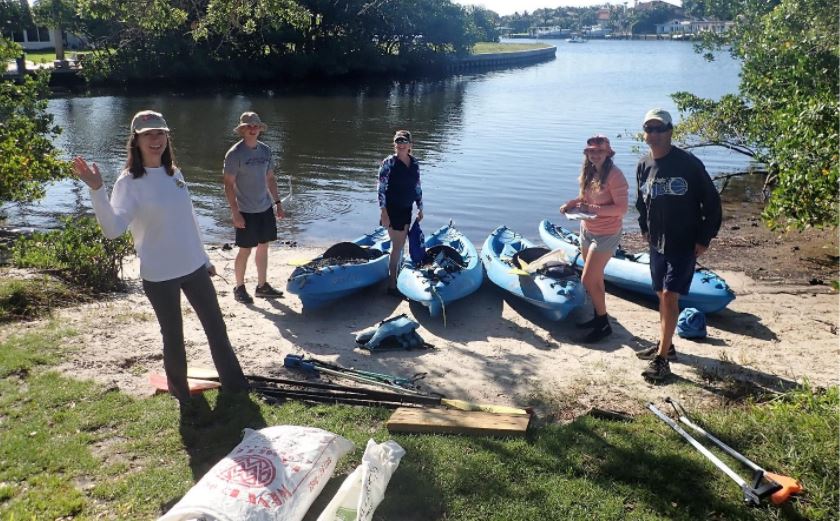Educators, citizen scientists, community activists, and nonprofits are all contributing to improving the health of Tampa Bay, this region’s flagship.
The Tampa Bay Estuary Program, each year, awards Bay Mini-Grants to various organizations to help accomplish this. It awarded 21 mini-grants this year using funding from Florida’s Tarpon license plate, totaling $93,000. Grants can run as high as $5,000.
The mini-grant program helps the estuary program to meet its goals as laid out in a master plan that includes restoration, education, and research, said Community Programs Scientist Sheila Scolaro. “We get a wide variety of projects, all offered to community programs, which is what makes this funding program unique.”
An advisory committee determines which projects get funded.
This year, Seminole High School received a grant to do a landscape architecture project and the nonprofit Tampa Bay Watch got funding for a living shoreline monitoring program, which uses citizen scientists.
“We like to fund restoration and education programs, along with some research,” Scolaro said. “A lot of people think of Tampa Bay as just the water, but it also is what is happening in the watershed. Everything we do living around the bay, even up into Pasco County, affects Tampa Bay. We don’t just focus on the water, but also on restoring native areas.”
There is also a volunteerism aspect to each program awarded a grant, which helps those involved get buy-in, she said. “The community is at the heart of our restoration story, so it definitely gives buy-in. If you put plants at your neighborhood park, you are going to feel more attached, like you are playing a part.”
Each mini-grant project helps the bay in a unique way, Scolaro said. “The Florida Aquarium is educating teachers through a workshop on how to tackle environmental threats to Tampa Bay through the classroom. They understand the threats like climate change and nutrient pollution, and they can go forth and educate students on reducing fertilizers, picking up after their dogs, and things like that. Tampa Audubon is doing a burrowing owl restoration program which helps restore habitat for a native species, which also helps the ecosystem of the bay.”
For now, applications for mini-grants are closed but will reopen in July for 2022. The Tampa Bay Estuary Program provides a packet that outlines the mini-grant program, the responsibilities for those receiving the grants, and what to include to make it more likely a group will get a grant.
Once projects are complete, the estuary program uses the information it obtains in many ways. For example, if it is lesson plans, they are shared through the website for other teachers to use.
“If it is a restoration project, we have a habitat master plan with very specific goals for restoring and improving habitat,” Scolaro said. “Any restoration done goes into our metric to check our goals. We report that out to the community, and we report it to the Environmental Protection Agency and otherwise get it out there.”
Each group does reporting, tracks deliverables, and shares how they developed their scope of work.
Here are some examples of 2021 Mini-Grant Awards:
- Audubon Florida received $5,000 to restore five acres in the Bird and Sunken Islands of the Alafia Bank Bird Sanctuary by managing invasive species.
- Byrne Ocean Conservation-Water Warrior Alliance received $5,075 for a trash collection tournament with a chance for individuals to win up to $10,000 in prizes for trash collection.
- Eckerd College received $5,000 to use a combination of camera traps and signs at Fort DeSoto County Park in conjunction with a maintained website to increase public understanding of the local wildlife and its natural communities.
- Keep Pinellas Beautiful received a $5,000 grant to improve environmental conditions through targeted marine litter abatement, public green space revitalization and educational programming for the Brooker Creek, Lake Maggiore and Salt Creek watersheds.
- Canterbury School of Florida received $3,500 for seniors and faculty to install a stormwater mitigation rain garden. Students will learn and explore the importance of green infrastructure and rainwater mitigation by transforming a storm drainage area into a dynamic rainwater garden to uptake nutrients, revitalize groundwater and minimize stormwater runoff.
- Minorities in Shark Sciences received $4,986 for its Science by the Sea program which encourages environmental stewardship and exposes teens and their families to their local marine and coastal ecosystems. This program focuses on underserved communities in Manatee County.
To learn more about the Bay Mini-Grant Program, visit the Tampa Bay Estuary Program website.




























